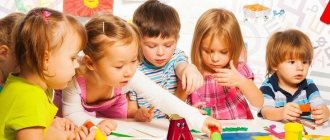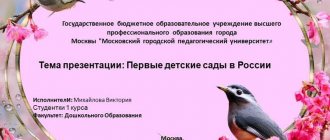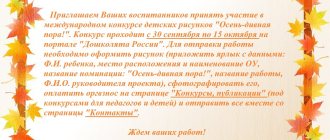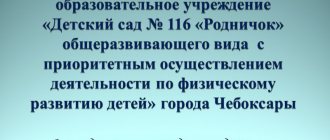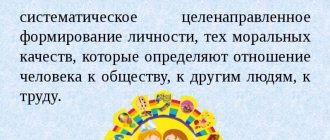The magazine “Preschool Education” is well known to all kindergartens. And it is prestigious to publish material in it.
The journal accepts for publication original, completed scientific and scientific-methodological works of a practice-oriented nature, carried out in the context of current problems in various fields of pedagogy, psychology and related disciplines. The materials provided must reveal various meaningful psychological and pedagogical aspects of the upbringing, development and education of children from 0 to 7 years old; concepts, models, systems for organizing the pedagogical process as a whole or its individual components in the context of preschool education; issues of organization and management of educational institutions at different levels; advanced training of teachers and personnel training.
The article must be written in literary Russian, in a scientific and methodological style, new concepts introduced must have definitions. The material in the article must be systematized, have a clear structure, an evidence base, reveal the problematic nature of the issues covered, and show ways to solve the problem based on the results obtained in the study.
The article must have a practice-oriented orientation, contain materials that allow them to be used in the mass experience of an educational institution, and be accompanied by clarity that reveals the content of the material and confirms the effectiveness of the proposed work. This is especially true for productive activities; articles from work experience. It should be distinguished by novelty, originality, revealing pedagogical creativity and skill of teachers.
Articles must indicate:
- sources (books, manuals, Internet resources, etc.) that formed the basis (used) of the presented material,
- authors whose ideas and books were developed in the proposed publications;
- authors of poems, for songs - authors of music and words.
All articles are reviewed and (or) considered at meetings of the editorial board. The period for reviewing the article is at least three months. No fee is charged from graduate students for the publication of scientific and methodological articles on dissertations. Publication of these articles is royalty-free. The editorial board reserves the right to literary and scientifically edit the content of the article in agreement with the author.
Procedure for submitting materials
An article for the journal is sent to the editorial office by registered mail, by e-mail, or delivered in person.
The article must be submitted by the author in the following package:
- text of the article in Russian and drawings (photos, graphs, tables) on electronic media (floppy disks, CD-ROM, etc.);
- printout of the article with pictures (for archival storage):
The article must be signed by the author.
The period for reviewing materials by the editors is up to three months. After accepting materials for publication, all authors enter into a license agreement with the Publishing House “Education of a Preschooler” in order to comply with copyrights and obligations, both on the part of the publishing house and on the part of the authors. The agreement is sent to the author (team of authors) for signing with a covering letter.
Read more about the rules of publication in the journal “Preschool Education”.
Website of the publishing house “Education of Preschool Children” https://dovosp.ru
Psychological characteristics of preschool children
After the crisis of three years and entry into preschool childhood, the child begins a stable, relatively calm period of development. The child can now choose his own activity, freeing up the adult’s attention. The initiatives and proposals of an adult no longer cause a storm of protest in the child. And, as before, the child needs support, encouragement for his efforts and respect for his needs. In his behavior, a preschool child is already more restrained, the ability to act thoughtfully appears, and not following the lead of his momentary desires, as was previously the case.
Along with the fact that the child is still quite dependent on the adult, his level of independence is constantly increasing. It is necessary to support his aspirations, demonstrate respect for his opinion, his interests. It is in this way that in raising a preschool child, conditions are created for the formation of such personal qualities as independence, determination, and initiative. The development and education of preschool children should also be carried out taking into account the characteristics of the cognitive sphere of children of this age.
The amount of material that a child can remember increases, but his memory is even more involuntary. That is, what is interesting to the child is remembered, what evokes an emotional response in him.
The preschooler's perception becomes more meaningful. The child correlates new information about the surrounding reality with past experiences. This allows him to move from visually effective forms of thinking to visually figurative ones. The development of thinking in a preschool child is aimed at developing the ability to analyze, compare objects, and establish connections between them. Thus, the prerequisites are created for developing the ability to draw conclusions and generalize the experience gained.
Intellectual development of preschool children
The development of preschool children involves creating optimal conditions for the child to master new forms of thinking, improve memory, stimulate imagination, and develop stability of attention.
Developing imagination. Involving children in role-playing games helps develop their imagination. By taking on a role, using game attributes, the child learns to create an imaginary situation.
Learning to think. To help a child learn to think, you need to offer him tasks in which he is required to be observant and choose the most convenient way to solve them. Preschool children enjoy playing with construction sets and mosaics, which help create objects according to a model and idea. The development of the ability to compare objects is helped by tasks to find an extra object or one that would correspond to a certain characteristic (color, shape).
We develop speech. In preschool age, speech actively develops. The child acquires the ability to correctly express his thoughts and maintain a dialogue. His active desire to learn more about the world around him helps to accumulate vocabulary. The task of an adult in raising a preschooler is not to ignore the child’s questions, to discuss with him the book he read, the cartoon he watched, and simply the events of the day.
Also, the development and upbringing of preschool children may involve the implementation of tasks aimed at learning letters and the formation of mathematical concepts. Such tasks should be interesting for the child, easy for him, so that learning evokes positive emotions in the child.
The speech apparatus of a preschooler is already practically formed, so the child is already capable of pronouncing all letters. Speech therapy correction at this age will bring great success if the child exhibits some speech defects or incorrect pronunciation of some letters.
Formation of readiness for schooling
A child’s psychological readiness for the school process is one of the most important outcomes of preschool development. When a child begins attending school, the life of a child changes significantly: the routine changes, the level of mental stress increases, conditions arise that require the ability to exercise volitional efforts and self-control. The success of adaptation to new conditions is largely determined by the child’s readiness for such changes.
Positive answers to the following questions may indicate that a child is ready to become a schoolchild:
- Does he want to gain new knowledge?
- Is he interested in communicating with new children?
- Is he in a good mood playing the role of a schoolboy?
Preschool education of children involves creating a positive attitude in the child towards the role of a student, because everything begins with the desire to learn.
Successfully preparing a child for school means:
- instill in him a positive attitude towards educational and social activities;
- make him realize the importance and necessity of schooling;
- arouse his interest and desire to become a schoolchild;
- develop a desire to learn to read.
A good motivator for a child will be the example of older sisters, brothers or friends who are already in school. Also, games at school with changing roles “student”, “teacher”, reading and discussing books, contacts with other children and peers, and teaching independence will help overcome difficulties in preparing a child for school.
Main directions of preschool education of children
Entering preschool age means that it is time to gradually prepare the child for school. Therefore, the first task of the development and education of preschoolers is to improve mental functions (memory, attention, thinking, perseverance) and to develop in the child a base of knowledge, skills and abilities that will help him successfully adapt to school. The social and moral side of the educational process is also important. In general, parents and teachers of preschool educational institutions must create conditions for nurturing a child’s harmonious personality, capable of overcoming life’s difficulties. A mentally balanced child with a high-quality base of preschool knowledge who knows how to get along with peers has a better chance of easily going through the adaptation period in elementary school. Children who have good moral and social preparation more often than others become leaders in the team and, as a rule, are respected by classmates and teachers.
In general, the entire educational process is aimed at:
- development of the child’s intellectual abilities;
- improving physical qualities and strengthening physical health;
- formation of everyday behavior skills;
- development of cultural and hygienic skills;
- labor and creative education of preschoolers;
- consolidation of moral and social norms of behavior.
Physical education of preschool children
The activity of a child in everyday life creates conditions for the development of his physical skills, because one way or another he has to run, jump, climb, throw and catch a ball during games. In kindergarten, the direction of physical education of preschoolers is implemented in special classes, in a complex of morning exercises, outdoor games held indoors and in the fresh air. The importance of involving a child in these activities is that in this way not only physical qualities (dexterity, strength, speed) are developed, but also health is improved.
Parents who are raising children at home should remember that changing activities helps to avoid overwork in the child. Therefore, education in preschool age should be organized in such a way that after activities that require perseverance, active play must certainly follow.
The high activity of a child in preschool age sometimes affects the quality of his sleep. If your child has trouble falling asleep, it is recommended to create a calm, relaxing atmosphere before bed. This could be a ritual of reenacting a specific activity every day before the child goes to bed. The calming effect may have:
- writing fairy tales;
- Reading books;
- bathing;
- massage.
Thus, while satisfying a child’s natural curiosity by offering him various educational games and tasks, we should not forget that due to his age, he quickly gets tired and needs proper rest.
Author's methods of preschool education
The issue of finding effective methods of teaching and raising preschool children always remains relevant. Today the most popular methods are:
1 Nikitin’s methodology, which provides for the development of preschool children in the most natural conditions, with an emphasis on stimulating creativity, involving parents in the educational process and ensuring a sufficient level of physical activity for the child.
- Maria Montessori's method, which involves creating for a child an environment that will help him independently explore the world, obtain a variety of information about surrounding objects and phenomena, attaches great importance to sensory development, learning to read, the formation of mathematical knowledge, and stimulation of speech development.
- Glen Doman's method is based on the assertion that a child should learn about the world by becoming familiar with facts.
Any technique aimed at the development of preschool children, with the right approach, can bring results. However, their use should not contradict the interests and needs of the child, his individual characteristics.
Moral education of preschool children
A preschool child has the opportunity to communicate with a large number of people. His experience of interacting with others in various situations also becomes more diverse. And it is precisely in preschool age that the understanding comes that there are rules of behavior common to everyone, certain standards of morality. By playing and communicating with peers, a preschooler learns to understand the feelings of other people, react to them correctly, and evaluate his actions.
For the child, such experiences as sympathy, resentment, guilt, pride and others become clear. He can clearly understand what is good and what is bad.
Education in preschool age should help the child, by analyzing the experiences of others and his own, to understand what a model of moral behavior should be. It is worth recalling that the best model of behavior is the child’s parents. Therefore, parents of a preschooler should try to be a worthy example for their child.
Social development of a preschooler
The upbringing of preschoolers must take into account that the child’s social circle at this age expands significantly. He learns to interact with peers by playing on the playground and attending preschool.
He may have to face the first misunderstandings and the need to defend his opinion. Since the child is just learning, an adult must show him what behavior can be in certain situations. This is best done in games. Children, as a rule, are happy to engage in role-playing games with a given adult plot.
In the process of communication, the child acquires social experience, which is provided by the people around him: peers, kindergarten teachers and parents. The child actively communicates and exchanges information, as a result of which so-called social competence is achieved
Social adaptation occupies an important place in the process of raising preschool children. In society, children learn to live by certain rules and take into account certain norms of behavior. Socially maladjusted children will find it very difficult to make contact with adults or their peers, and this can lead to antisocial behavior in the future. Failure to master cultural skills and necessary social qualities makes it difficult for children to adapt in the lower grades, and most often leads to school maladjustment.
“Electronic journal of a preschool teacher”
- November 9, 2015
Competition “My Pedagogical Initiative - 2015”
Nomination “New educational standards in my practice”
In educational organizations today, the time has come that computers are not perceived as something unreal, then preschool institutions cannot remain on the sidelines, especially since, according to the new law on education, preschool institutions now belong to the first level of education in the Russian Federation.
Due to the fact that our institution has included a kindergarten since 1991, the process of informatization, having begun its penetration from secondary, primary and primary schools, gradually moved into the preschool department. I would like to note that this vector of development is now actively supported by government policy and occupies an end-to-end line in regulatory documents.
Modern realities of life impose not only maternal feelings of love and care for children on the teacher, but also force the teacher-educator to use information and communication technologies in his professional activities. Now a teacher, like a school teacher, must not only use a computer as a means of multimedia support, but also use it as a means of managing the educational process in his group, preschool institution. On the other hand, increasing demands on educators from customers of educational services require him to devote more time not only to children, but also to maintaining various reports accompanying the child’s development process, as one of the means of recording his educational results in a preschool institution.
For this purpose, our school has developed an electronic magazine “EDUCATOR”.
The purpose of developing the magazine was:
1. Connection of all information flows of the teacher into one information node. 2. Systematization of information collected by the teacher about each child and group into a single information resource. 3. Creation on the basis of the magazine of a comprehensive model of information and methodological support for the educational process of a preschool institution.
The electronic journal embodies all the requests of the teachers of our preschool institution. It includes those pages that educators need in their daily painstaking work.
The electronic journal “Educator” contains 33 sheets, each of which has its own function.
- 1 sheet. "Characteristics of the group." Here the teacher gives a general description of the students in his group.
- 2 sheets. “List of the group with personal data.” On this page, the teacher enters personal data about the students and their parents, this page is key, and from this page all information will be duplicated as necessary. The age of each student and the total number of girls and boys in the group are automatically calculated.
- 3 sheet. "Progress ».
- 4 sheets. "Group duty schedule."
- 5 sheet. "Errands."
- 6 sheets. "Attendance".
- Sheet 7 “Health Sheet”.
- 8 sheet. "Seating chart ».
- Sheet 9 “Employment”.
- 10 sheets. "Leisure".
- Sheet 11 “Movement”.
- Sheet 12 “Accounting for payment for preschool education”.
- Sheet 13 “Minutes of parent meetings.”
- Sheet 14 “Topics of parent meetings.”
- Sheet 15 “Attendance at meetings.”
- Sheet 16 “Daily routine”.
- Page 17 “Group Social Passport”.
- Sheet 18 “Psychological portrait of the group.”
- Sheet 19 “Participation in competitions.”
- Sheet 20 “Parental Committee”.
- 21 sheets of “Case Diary”.
- Sheet 22 “Goals and objectives».
- Sheet 23 “Work plan”.
- Sheet 24 “Financial activities”.
- Sheet 25 “Work cyclogram”.
- 26 sheet “Grid of activities”.
- Sheet 27 “Thematic planning”.
- Sheet 28 “Cyclogram of educational activities outside of class.”
- Sheet 29 “Perspective lesson plan.”
- Sheet 30 “Work schedule”.
- 31 sheets “Summer thematic planning”.
- 32 sheet “Self-education”.
- Sheet 33 “Equipment”.
The introduction of an electronic journal into the educational process of a kindergarten has shown many advantages:
- Close contact in the teacher-parent chain.
- Efficiency of management and the ability to compactly store large amounts of information.
- Combining various information flows into a single journal.
In the reflection questionnaire, the teachers of our preschool department expressed only positive feedback about the appearance and implementation of the magazine in the activities of teachers.
“Electronic journal of a preschool teacher.”
Author: Alexey Aleksandrovich Lobanov, computer science teacher, deputy director of MBOU “Secondary School No. 11” in Angarsk, methodologist of the education support center in Angarsk. Angarsk.
